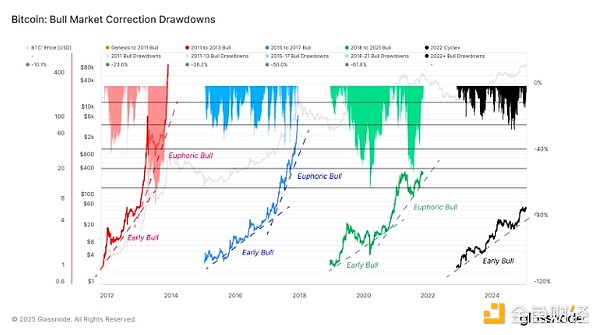
Author: Marie Poteriaiev, CoinTelegraph; Translated by: Wuzhu, Golden Finance
On February 3, Bitcoin fell below $92,000, shocking the cryptocurrency market and triggering liquidation of up to $2.1 billion Essence Initially, investors seemed prepared for the economic hardships brought about by U.S. President Donald Trump’s announcement of the tariff war. However, concerns soon shifted to whether Bitcoin has peaked and is about to enter a downward trend.
More worryingly, Bitcoin Archive noted that every BTC bull market in the past has peaked within 330 days after breaking the all-time highs of the previous cycle. February 4 is the 328th day.
However, Bitcoin rebounded quickly after falling. The announcement of a suspension of tariffs on Mexico and Canada on February 3, and President Trump's cryptocurrency Tsar David Sacks, is scheduled to speak on February 4, seems to reassure the market.
This raises a question: whether the market rebounds too quickly. Macroeconomic and geopolitical challenges still exist, which poses risks for Bitcoin traders to fall into a bull trap.
Bitcoin demand remains strongAs the tariff war panic suggests, Bitcoin demand remains strong, continuing to absorb a pullback—even at all times highs of over $90,000.
Glassnode's analysis of the bull market decline in Bitcoin shows that demand for BTC may rise, which may trigger a "second rising phase" in the market. Historical data shows that over the past three cycles (2011-2015, 2015-2018 and 2018-2022), the correction averaged about 25%, followed by accelerating price performance during the last third of the bull market. The current bull market has not yet experienced such acceleration.
Bitcoin bull market corrected the retracement. Source: Glassnode
A key indicator to focus on when it comes to supply is the long-term/short-term holder threshold. It tracks capital rotations from long-term investors to new buyers, giving a clearer picture of supply dynamics.
The peak of Bitcoin cycles is usually consistent with the time when long-term holders take profits and sell their tokens to new buyers. Glassnode data shows that this is not the case at present. Although long-term holders have transferred more than one million BTC to new buyers since November, they still hold a considerable share of supply, indicating their confidence in future price increases.
Bitcoin long-term holder threshold. Source: Glassnode
How high can Bitcoin rise in 2025?Glassnode other data shows that so far, the 2022-2025 year cycle and The 2015-2018 cycle is very similar. However, the possibility of a complete repetition is unlikely. In 2017, Bitcoin’s all-time highs allowed its price to grow 113 times, while the next peak brought a 20-fold return. With Bit The currency is mature, and the growth rate of each cycle is declining, and more and more capital inflows are needed to maintain the new price level.
So far, BTC has been low in the December 2023 cycle Point 16,000 rose 6 times, indicating that the expected multiplier is between 10 and 13 times. This means the peak is between $160,000 and $210,000 – a target range consistent with the forecasts of many analysts. VanEck Digital Assets Research director Matthew Sigel expects the price of Bitcoin to reach $180,000, while Bitwise Asset Management and Bernstein expect the price of Bitcoin to reach $200,000. Tom Lee, a CNBC contributor and fundstrat managing partner, predicts the price of Bitcoin to reach $250,000 .
Bitcoin price performance since the cycle lows. Source: Glassnode
When will Bitcoin peak ?Technical analyst CryptoCon believes that Bitcoin’s relative strength index is quite accurate in determining cycle phases. RSI is a momentum oscillator used to measure the speed and amplitude of price movements, helping to identify the asset’s oversized Buy and oversell.
CryptoCon has identified a critical cycle phase by analyzing RSI approaching the 99% threshold. Their data shows that Bitcoin entered its fourth cycle phase last November, which Indicates that the market may peak around September to October 2025.
RSI Bollinger Band % stage. Source: CryptoCon_ /X
Another indicator that identifies the top of the market with historical accuracy is the top of the Pi cycle. This indicator tracks multiples of the 111-day moving average (111DMA) and the 350-day moving average (350DMA x 2). In previous cycles, when 111DMA exceeds 350DMA x 2, the price of Bitcoin peaks.
According to Bitcoin PiThe cycle top forecast, which infers these moving averages to estimate the next peak, is expected to peak around September 26.
Bitcoin Pi cycle top forecast. Source: Bitbo, PositiveCrypto
While no indicator is perfect, the market's resilience and ongoing demand suggest that the real top may still be ahead.











